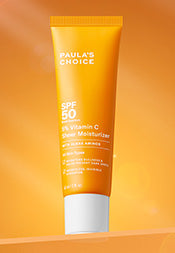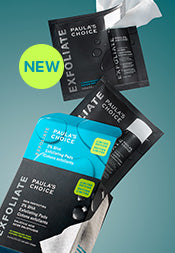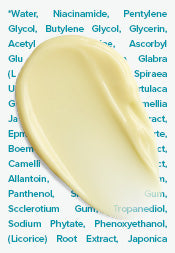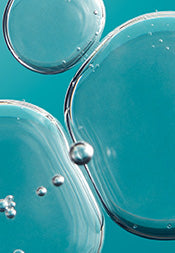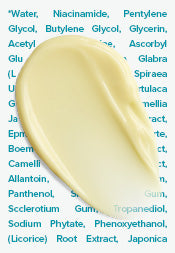AHA vs BHA: Know Your Facial Acids

If you’d like to achieve clear, smooth, and radiant skin, exfoliation is key to getting rid of dead skin cells and revealing the glowing skin underneath.
While physical exfoliants like scrubs offer a manual approach, chemical exfoliants like facial acids are a more refined, more effective way to remove dead skin cells and address various skin concerns. These dissolve the bonds that hold dead skin cells to the surface which helps to reveal the fresher, healthier skin beneath.
When choosing a facial acid, you’ll commonly run into two main types: AHAs and BHAs. While both are effective as chemical exfoliants, understanding what they are and the difference between how they work is key to optimising your skincare routine and achieving your desired results.
What are Alpha Hydroxy Acids (AHA)?
Alpha hydroxy acids (AHA) are a group of water-soluble acids predominantly derived from natural sources. Common examples include glycolic acid (derived from sugar cane), lactic acid (from milk), mandelic acid (from bitter almonds), and citric acid (from citrus fruits).
AHAs work by gently loosening the bonds between dead skin cells on the uppermost layer, allowing them to shed more easily and revealing the newer, healthier skin underneath. This makes AHA skincare particularly effective for concerns related to the skin's surface. Do be careful though as at higher concentrations, AHA exfoliants can disrupt the skin barrier and cause irritation.
Benefits of AHA Skincare
- Smoother, Softer Skin: By removing accumulated dead skin cells, AHAs immediately contribute to a noticeably smoother and softer skin texture. This is especially beneficial for those experiencing dullness or rough patches.
- Reduces Signs of Aging: Some studies have found that AHAs can stimulate collagen production within the skin. Collagen is vital for maintaining skin's firmness and elasticity, so this stimulation helps to minimise the appearance of fine lines, wrinkles, and other common signs of aging.
- Enhances Radiance and Even Tone: The removal of dead, dull skin cells reveals a more radiant and luminous complexion. AHAs are also particularly adept at addressing minor discolouration and superficial dark spots, helping to create a more uniform appearance.
- Improves Skincare Product Penetration: When dead skin cells are no longer forming a barrier on the surface of your skin, other skincare products such as serums and moisturizers can penetrate more into your dermis effectively. This enhances their overall performance and ensures you get the most out of your routine.
What are Beta Hydroxy Acids (BHA)?
Beta Hydroxy Acids, unlike AHAs, are oil-soluble. This allows them to not only exfoliate the skin's surface but also to penetrate deep into the pores. This makes BHAs such as salicylic acid excel at exfoliating both the skin's surface and the inside of the pore lining, making it highly effective for concerns that originate within the pores themselves.
Benefits of BHA Skincare Products
- Targets Blackheads and Whiteheads: Due to its ability to penetrate oil, BHA can effectively dissolve the sebum and dead skin cell buildup inside pores. This makes it incredibly efficient at treating and preventing blackheads and whiteheads.
- Manages Acne and Breakouts: Salicylic acid is the most well-known BHA in skincare. It possesses anti-inflammatory and comedolytic (pore-unclogging) properties, making it a powerful ingredient in managing acne. It also helps to calm redness and swelling associated with breakouts while preventing new ones from forming.
- Regulates Sebum Production: BHAs can help to normalise oil production within the pores, which is beneficial for those with excessively oily skin.
- Gentler for Some Sensitive Skin: While powerful, BHAs can sometimes be less irritating for certain individuals, particularly those with acne-prone or sensitive skin, due to their anti-inflammatory properties.
- Soothes Irritated Skin: The anti-inflammatory benefits of BHAs can help to soothe and calm irritated skin, reducing redness and discomfort often associated with breakouts.
The Difference Between AHAs vs BHAs

Understanding the distinctions between AHAs vs BHAs is essential for choosing the most effective product for your skin. Here’s a clear breakdown:
|
AHA |
BHA |
|
|
Solubility |
Water-soluble, working primarily on the outermost layer of the skin. Ideal for: Addressing surface-level texture and tone concerns. |
Oil-soluble, able to penetrate through sebum and into the pore lining. Ideal for: Addressing pore-level concerns. |
|
Primary Actions/Benefits |
Effective at surface-level exfoliation resulting in improving skin texture and brightening the complexion. Can also stimulate collagen to improve overall skin condition. |
Effective at unclogging pores, addressing oil- or sebum-related concerns like blackheads, whiteheads, and acne, and providing anti-inflammatory benefits. |
|
Ideal Skin Types/Concerns |
Generally suited for normal to dry skin types, especially those concerned with sun damage, dullness, signs of aging, and mild hyperpigmentation. |
Generally suited for oily, combination, and acne-prone skin, as they can effectively target blackheads, whiteheads, and inflammation. |
AHA or BHA: Which Should I Use for My Face and Skin Type?
Deciding whether to use AHA or BHA (or both!) depends entirely on your skin type and specific concerns.
- For Dry, Sun-Damaged, or Mature Skin: If your primary concerns are dryness, sun damage, rough texture, or fine lines, an AHA skincare product like the Daily Smoothing Treatment 5% AHA could help with retexturising and promoting a more youthful glow.
- For Oily, Acne-Prone, or Congested Skin: If you struggle with oiliness, blackheads, whiteheads, or breakouts, a BHA like salicylic acid is your best bet. Its ability to penetrate oil and exfoliate inside the pores will be highly effective in clearing congestion.
- For Combination Skin: For those with combination skin, you might find that using both AHA and BHA products is beneficial. You could use an AHA exfoliant for areas of dryness or sun damage and a BHA like the 2% BHA Gel Exfoliant for oilier, more breakout-prone areas (like the T-zone), or alternate their use on different days.
- For Sensitive Skin: While both AHAs and BHAs can be used by sensitive skin types, BHAs are often tolerated better by those prone to redness or irritation due to their anti-inflammatory properties. Consider the 1% BHA Sensitive Skin Exfoliant which is intentionally formulated to be gentle.
Getting Your Skin to Glow
Understanding the unique characteristics of AHA vs BHA products empowers you to make informed decisions about your skincare. By recognising the difference in how they work and aligning this with your skin's specific needs, you can unlock a clearer, smoother, and healthier complexion. Just remember to always consider the concentration of the acid and the overall formulation of the product, and patch test new products first.
Paula's Choice Skincare offers a variety of well-formulated AHA skincare and BHA skincare products designed for different skin types and concerns, ensuring stability and efficacy without common irritants. We even offer combined products like the 25% AHA + 2% BHA Exfoliant Peel for a more thorough resurfacing as well as unclogging of your pores. Whether you opt for an AHA exfoliant to refine surface texture or a salicylic acid exfoliant to penetrate deeper into your pores, knowing your facial acids is the key to unlocking your youthful glow.
References for this information
- Tang SC, Yang JH. Dual Effects of Alpha-Hydroxy Acids on the Skin. Molecules. 2018 Apr 10;23(4):863. doi: 10.3390/molecules23040863. PMID: 29642579; PMCID: PMC6017965.
- Almeman AA. Evaluating the Efficacy and Safety of Alpha-Hydroxy Acids in Dermatological Practice: A Comprehensive Clinical and Legal Review. Clin Cosmet Investig Dermatol. 2024 Jul 16;17:1661-1685. doi: 10.2147/CCID.S453243. Erratum in: Clin Cosmet Investig Dermatol. 2024 Aug 30;17:1973-1974. doi: 10.2147/CCID.S493491. PMID: 39050562; PMCID: PMC11268769.
- Lu J, Cong T, Wen X, Li X, Du D, He G, Jiang X. Salicylic acid treats acne vulgaris by suppressing AMPK/SREBP1 pathway in sebocytes. Exp Dermatol. 2019 Jul;28(7):786-794. doi: 10.1111/exd.13934. Epub 2019 May 15. PMID: 30972839.
- Kornhauser A, Coelho SG, Hearing VJ. Applications of hydroxy acids: classification, mechanisms, and photoactivity. Clin Cosmet Investig Dermatol. 2010 Nov 24;3:135-42. doi: 10.2147/CCID.S9042. PMID: 21437068; PMCID: PMC3047947.


